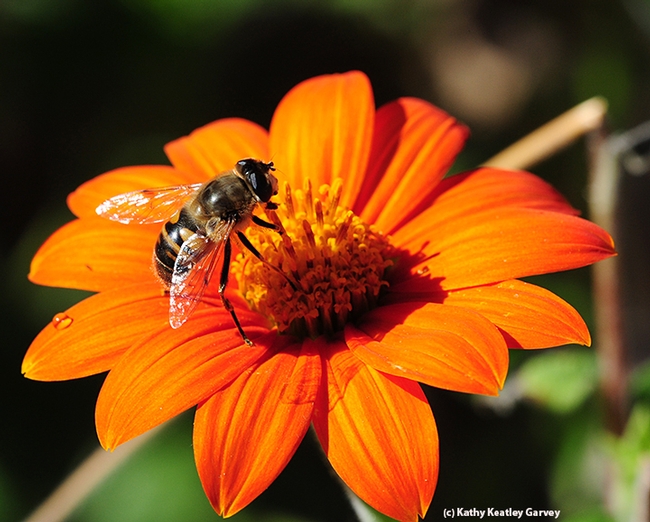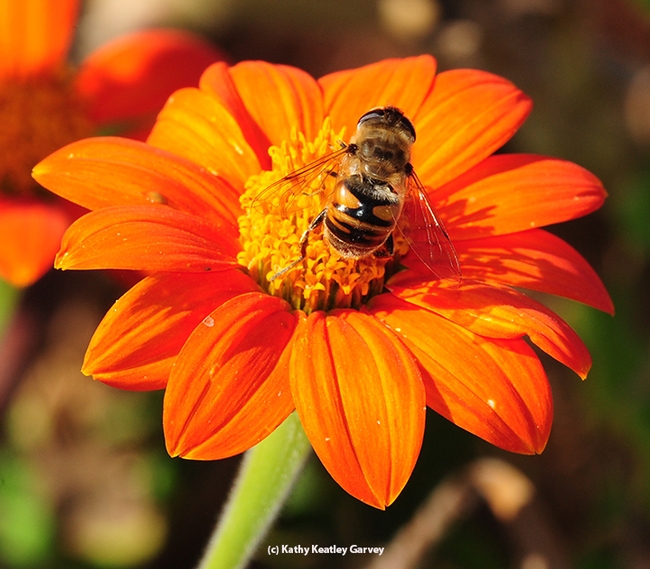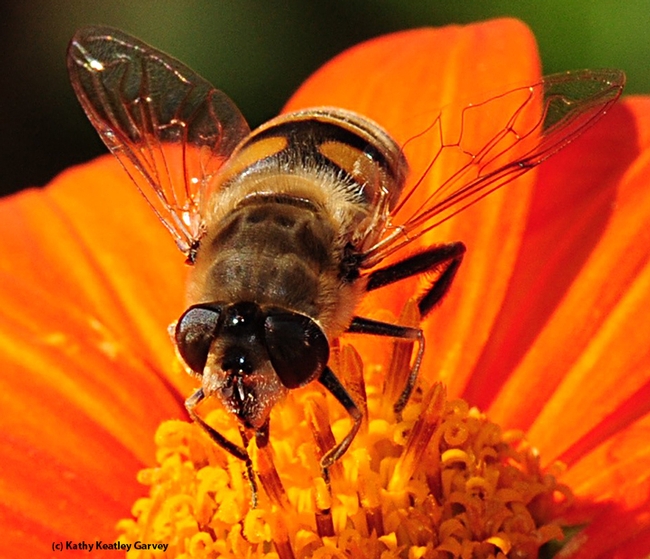- Author: Kathy Keatley Garvey
So you're walking along Doran Regional Park Beach in Sonoma County on Tuesday, Oct. 16 and thinking about the pollinators in your back yard. (Don't we all?)
And then: what a delight to see. Apis mellifera (honey bees) and Eristalis tenax, syrphid flies (better known as a "drone flies") nectaring on the tiny blossoms of a sea rocket plant (genus Cakile).
This particular plant species? The European sea rocket, Cakile maritima, a succulent annual that's a member of the mustard family. It grows in clumps or mounds on sandy beaches and bluffs along the coastlines of North Africa, western Asia, and North America. It boasts a long, slender and stout taproot.
You've probably seen it. But you may not have noticed the pollinators.
"Their leaves are fleshy," is how Wikipedia describes the plant. "Flowers are typically pale mauve to white, with petals about 1 cm in length. Each fruit has two sections, one that remains attached to the adult, and the other which that falls off for dispersal by wind or water."
At Doran Beach, two species of sea rocket (C. maritima or European sea rocket, and C. edentula or American sea rocket) bloom from spring through summer--and sometimes in early fall.
Bees at the beach? Floating fruit?
Yes, indeed.
And flies (syrphids), too.
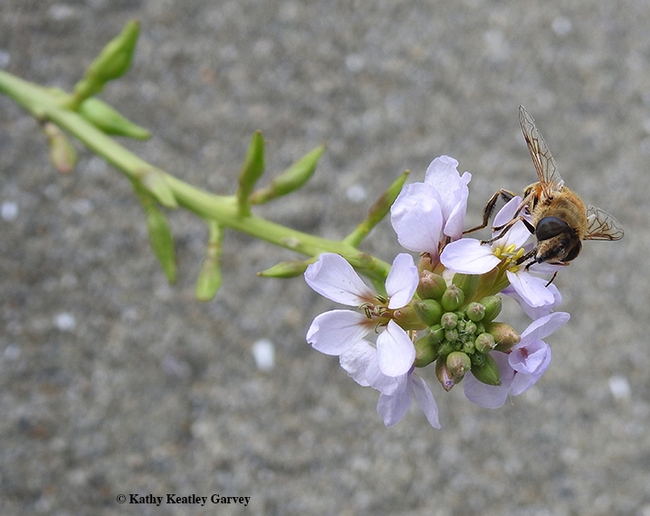
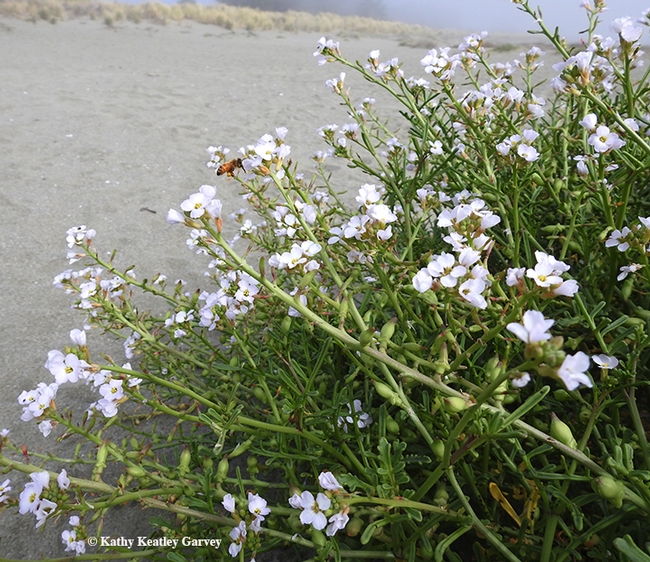
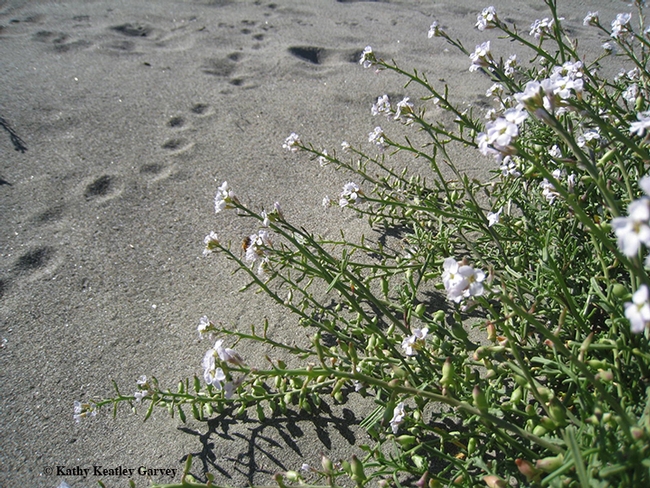
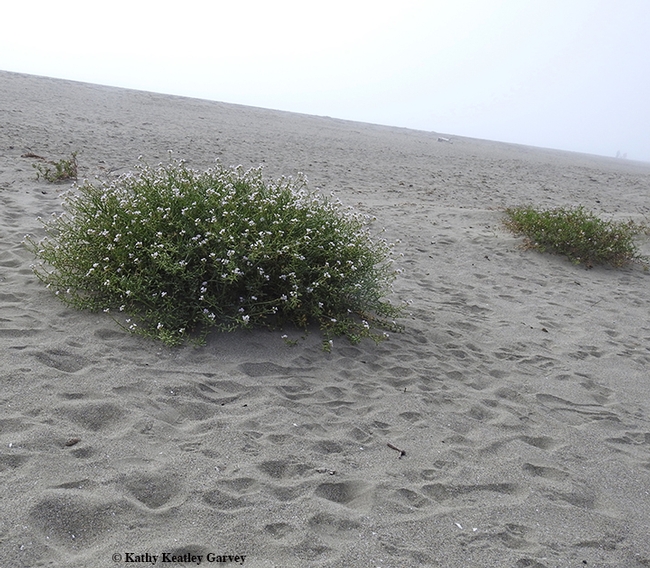
- Author: Kathy Keatley Garvey
You've heard of "musical chairs," that anxiety-driven elimination game involving chairs, music and players. When the music stops and a chair is eliminated, the players race for the remaining seats. No one wants to be the first loser.
Well, insects, too, play "musical chairs," but with flowers as chairs. The music: the flapping or buzzing of insect wings.
Such was the case this week as two syrphid flies, aka hover flies or flower flies, kept jockeying for the same Mexican sunflower blossom (Tithonia rotundifolia).
It was a close contest between the black hover fly or Mexican cactus fly (Copestylum mexicanum) and the hover fly (probably Eristalis tenax), which is often mistaken for a honey bee. Neither wanted to be the first loser.
Who won? Neither. They abandoned the "fight" and took flight, each heading for a different blossom to forage for more nectar and pollen.
Life is like that.
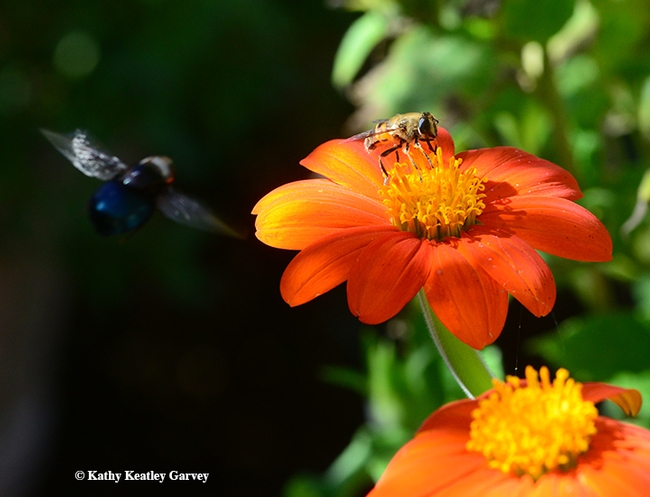
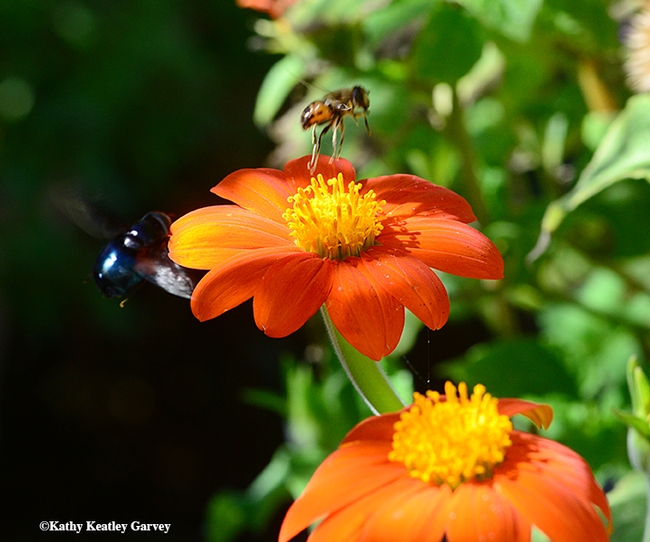
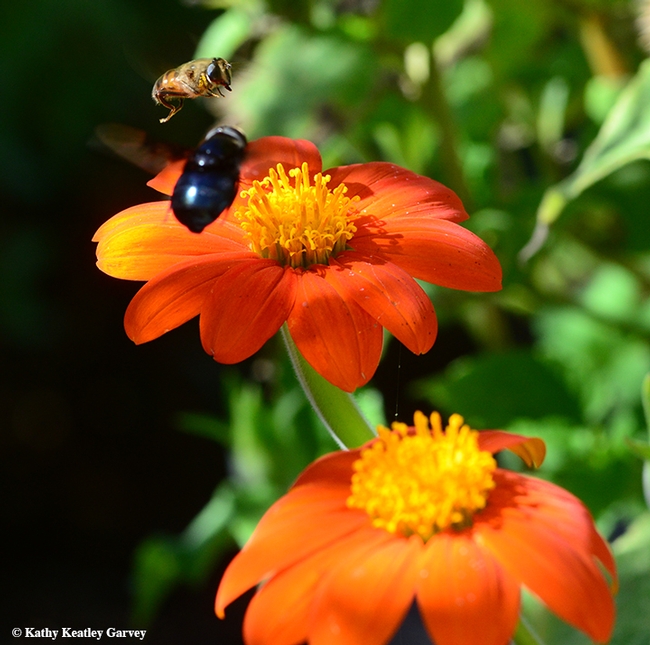
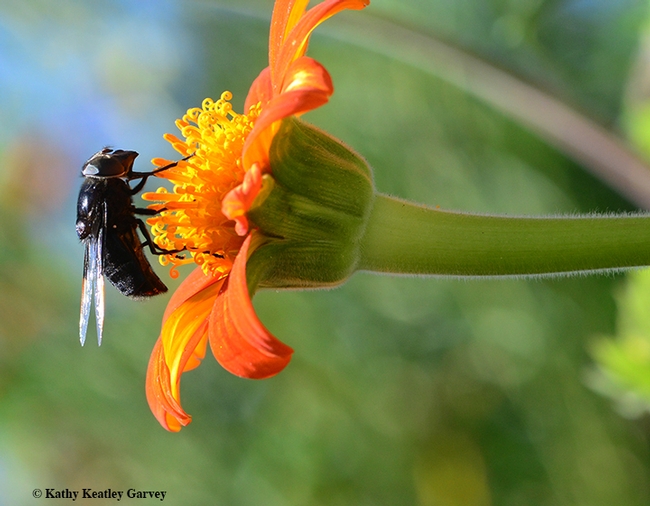
- Author: Kathy Keatley Garvey
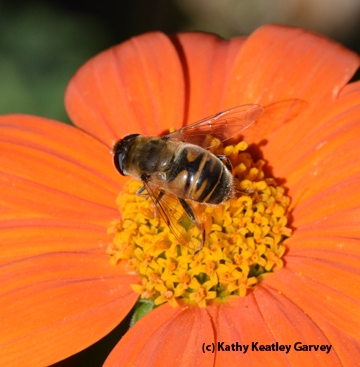
It's often mistaken for a honey bee. Hey, isn't every floral visitor a bee? No, not by a long shot. One's a fly and one's a bee.
That came to mind last weekend when we saw a large number of honey bees (Apis mellifera) and drone flies (Eristalis tenax) nectaring on Mexican sunflowers (Tithonia). The feeding frenzy brought back all the Internet images of mistaken identities. And the arguments.
That's a bee!
No, it's not. It's a fly.
That's no fly. That's a bee.
It's a fly. Bee-lieve me!
To the untrained eye, they look alike at first glance. They're both insects, they're about the same size, and they're both pollinators.
The drone fly, though, in its immature stage is a rat-tailed maggot that lives in drainage ditches, hangs out around manure piles and sewage, and its idea of a pool party is water that is badly polluted.
Honey bees gather nectar and pollen (and water and propolis) for their colonies. Nectar is their carbohydrate and pollen is their protein.
Drone flies mimic bees in color, size and nectaring behavior. They're actually hover flies, members of the family Syrphidae. Watch them hover over flowers like a helicopter.
Lately, we've been seeing an influx of drone flies in our little pollinator garden. Look closely at their large eyes and stubby antennae and you can easily distinguish them from honey bees. Then notice the "H" on their abdomen. Maybe that's "H" for hello? Or "H" for Halloween? Or, or "H" as in "Hey, I'm not a bee! I just mimic a bee so you'll think I'll sting you."
They're bluffing. Drone flies don't sting.
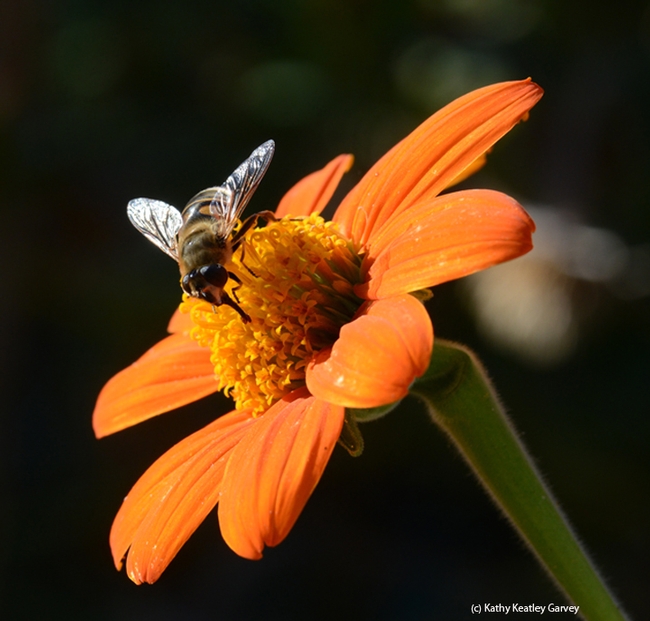


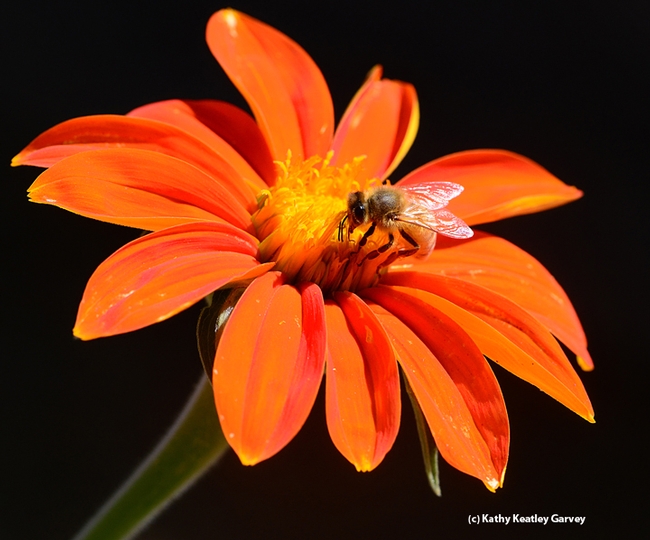
- Author: Kathy Keatley Garvey

Or, she might say "A fly is a fly is a fly."
Oh, my.
That's because major corporations, news media and people-who-should-know-or-who-should-at-least-fact-check are still confusing honey bees with flies.
May Berenbaum, 2016 president of the 7000-member Entomological Society of America (ESA) and a National Medal of Science recipient, recently received a solicitation letter from a well-known nature corporation asking her to help the honey bees.
All's well and good, right? Wrong. The photo on the envelope was not of her beloved honey bee. It was a photo of a fly. A syrphid fly.
Oops!
Never send a fly to an ESA president, the top of the entomological chain, and claim it's a bee.
Apparently this corporation--okay, the Sierra Club, as this is all over the Internet--obtained the "bee" photo from someone who could not distinguish certain species in the order Hymenoptera (which includes honey bees) and the order Diptera (flies). The drone fly, Eristalis tenax, is often confused with the honey bee, Apis mellifera. To entomologists, it's like confusing an elephant with a giraffe.
Berenbaum, who also has a keen sense of humor, posted a blurb on her Facebook page about the fly.
"Really, Sierra Club? You send a letter asking to help save honeybees with a photo of a syrphid fly on the envelope?" (She also pointed out that "honey bee" is two words, not one.)
That drew all kinds of comments:
- Save the syrphids!!!
- Is there a syrphid that mimics a honey bee? Maybe they fell for it.
- That is so terrible it's almost wonderful.
- Personally, I'm wondering who the heck is taking all of the pictures of syrphids!! Aren't bees a lot more common?
- I may have to use this in my next lecture about mimicry and how successful it can be, even against visual-based predators.
- May and I were close friends in high school and, I'm pretty sure that she is the smartest person I've ever met.
- Well, Eristalis tenax is just such a great mimic, I am proud of that species!
- I see images of bumble bees with "Save the Honeybee" on stickers. Kind of like "Save the Cow" with a picture of a bison, or worse. How to offer professional advice/fact checking for articles/media? Would love to do it!
- That's funny and sad at the same time!
- There are so many syrphid photos that have been used as bees, I begin to wonder if most people really don't know what bees look like!
But my favorite:
So we were sitting at the dinner table and a friend said "If only someone was running for president who was worth voting for."
Without missing a beat, my daughter said "What about May Berenbaum?"
You've now been duly nominated.
What do you think?


- Author: Kathy Keatley Garvey
Everyone's talking about the drones.
You know, the unmanned aerial vehicles (UAV). Those flying robots cruising over our heads--some with cameras for journalistic and research purposes and others with "need-to-know" purposes.
But in the entomological world, the word "drone" usually means a male honey bee. Or a fly. A drone fly.
To the untrained eye, the common drone fly (Eristalis tenax) looks somewhat like a honey bee, and flies somewhat like a honey bee. It feeds off pollen and nectar.
But the larva is known as a rattailed maggot and feeds off bacteria in drainage ditches, manure or cess pools, sewers and the like.
Like a worker honey bee, the adult drone fly is a pollinator and is often mistaken for a honey bee. Unlike a honey bee, however, it has one set of wings, large eyes, stubby antennae, and a distinguishing "H" on its abdomen.
Coming soon to a field near you--a drone (flying robot) and a drone fly (flying fly). Neither causes diseases nor sucks blood.
